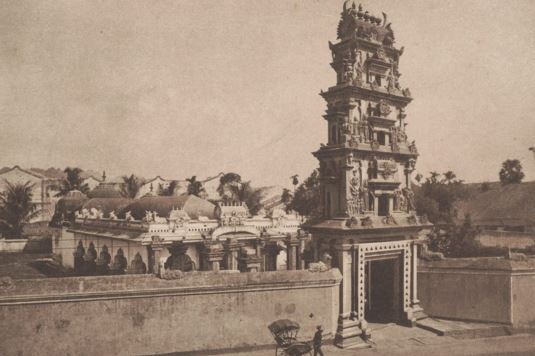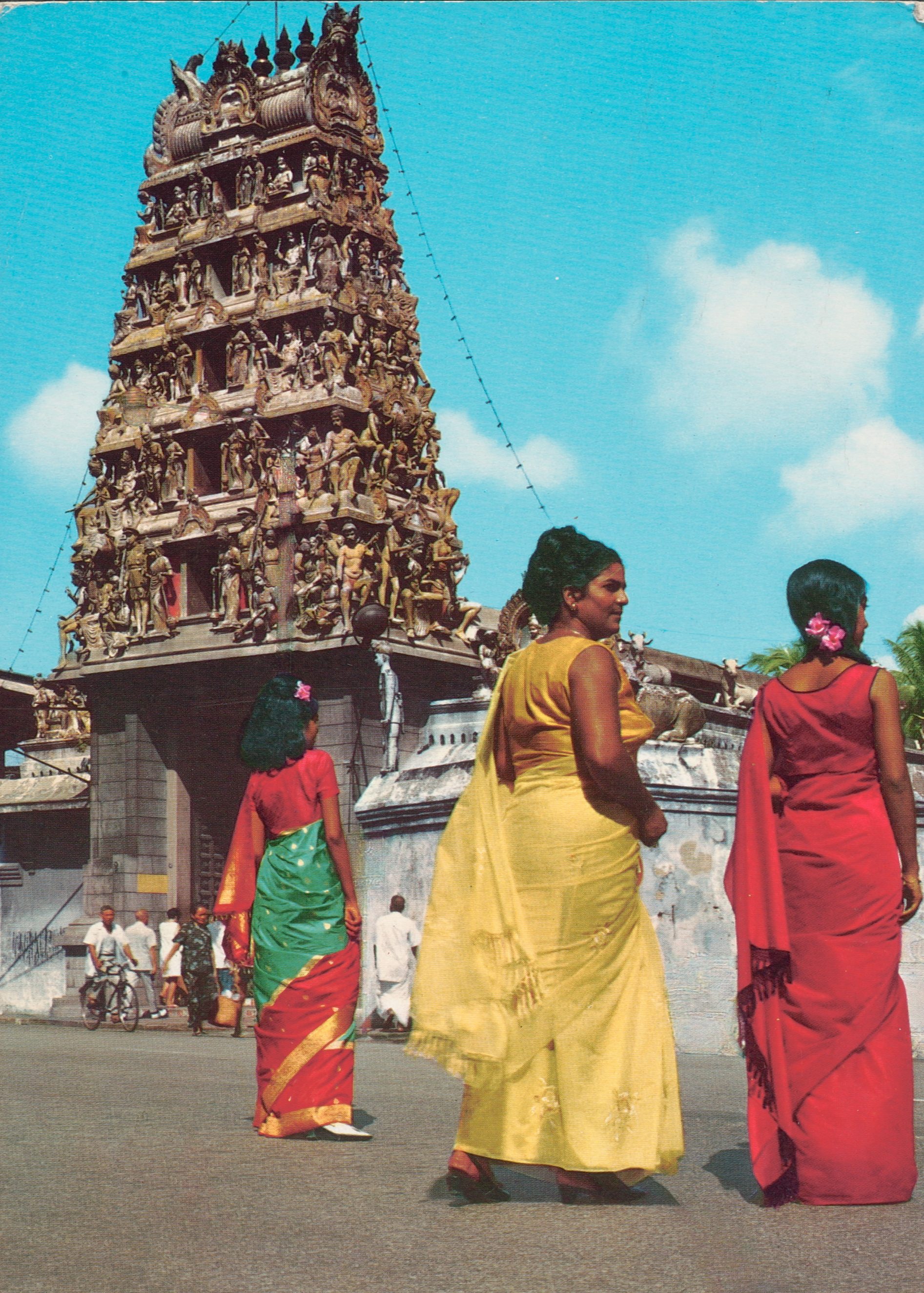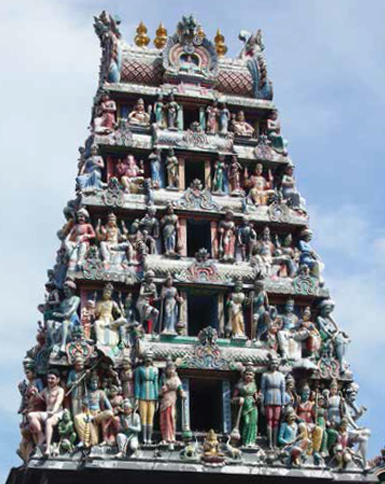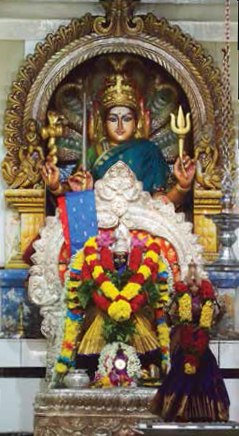Time-honoured Temple Design
Sri Mariamman Temple is Singapore’s oldest Hindu shrine. Anasuya Soundararajan and Sri Asrina Tanuri describe the architectural features of this landmark.
 Sri Mariamman Temple, c.1900. The three-tiered gopuram was a slimmer and sparsely decorated structure compared to the present five-tiered tower that was rebuilt in 1936. Courtesy of the National Museum of Singapore, National Heritage Board.
Sri Mariamman Temple, c.1900. The three-tiered gopuram was a slimmer and sparsely decorated structure compared to the present five-tiered tower that was rebuilt in 1936. Courtesy of the National Museum of Singapore, National Heritage Board.“Do not live in a place where there are no temples” cautions an age-old Indian aphorism. In keeping with the sagely advice of his forefathers, one of the first things that Naraina Pillai did after his arrival in Singapore in 1819 was to establish a Hindu temple for his fellow countrymen.
In 1827, four years after the land was acquired, Sri Mariamman Temple, Singapore’s oldest Hindu place of worship, finally stood proud along South Bridge Road. The nondescript wood-and-attap construction erected then was a simple affair compared to the splendidly intricate and colourful structure that attracts Hindu worshippers as well as busloads of tourists today.
Located in the heart of Chinatown, the temple’s elaborate gopuram1 has been a landmark for generations of Hindu worshippers in Singapore.2 In deference to its architectural and historical significance, the temple was gazetted as a national monument on 28 June 1973.3
Singapore’s First Hindu Temple
The history of the Sri Mariamman Temple is closely intertwined with the arrival of the first Indians to Singapore, soon after Stamford Raffles established a British trading post on the island in February 1819.4 South Indian migrants to Singapore, feeling displaced in a new land, brought with them the cultural and religious practices of the subcontinent, including the worship of Mariamman, the goddess of rain. In Hindu spirituality, the “mother” deity is known for her power to protect people from harm and to cure epidemic illnesses and diseases.5
It is not known which part of India Naraina Pillai originated from; he arrived in Singapore with Raffles on the latter’s second visit to the newly colonised island in June 1819, and is the first recorded Indian immigrant in Singapore.6 Prior to this, Pillai worked as a government clerk with the British East India Company in Penang. Good fortune favoured Pillai, and before long, he became a successful entrepreneur and community leader, and set up the island’s first brick kiln at Mount Erskine (present-day Tanjong Pagar). He also persuaded several Indian bricklayers, carpenters and artisans from Penang and South India to join him in Singapore. Recognising his growing influence in the Indian community, the British appointed Pillai as leader of the Indian community in December 1822.7
Pillai was greatly respected by the early Indian settlers in Singapore, who sought his advice and consulted him on important matters. He, in return, strived to improve the lives of the newly arrived settlers.8 Because religion and spirituality were so central to the lives of these Indian immigrants, one of the first things Pillai did was to apply to the East India Company for land to erect a Hindu temple.
In response, the British authorities allotted a plot of land along Telok Ayer Bay, where Telok Ayer Street is located today. Pillai declined the offer because the location was too far away from sources of fresh water that are so vital for Hindu temple rituals. Never one to give in easily, he continued to petition the East India Company officials to allocate a new site.9
In 1821, the British Resident William Farquhar granted Pillai a site close to the freshwater stream near Stamford Canal. However, the Town Planning Committee had other plans for the area, and Pillai’s hope of building a Hindu temple was once again dashed. It was only in 1823 that Pillai was finally given a suitable plot of land at South Bridge Road.10 The site is marked as “Kling Chapel”11 in the 1828 edition of the “Plan of the Town of Singapore”, first drawn in 1823 by Lieutenant Philip Jackson, the Surveyor of Public Lands appointed by Raffles.12
The temple that Pillai first built in 1827 was a simple wood-and-attap (palm frond) structure. This was replaced in 1843 by a brick building, thought to have been erected by Indian convicts13 and craftsmen from Madras (now Chennai), employed for their mastery in plasterwork.14 The major part of the temple’s present structure is believed to date back to another major reconstruction between 1862 and 1863.15 The sculptures and ornamentations added during this period were created by skilled craftsmen from the Nagapattinam and Cuddalore districts of Tamil Nadu in South India.16
With each extension, repair and restoration over the subsequent decades, Sri Mariamman Temple has become a rich physical repository of architectural history, its finely wrought structures and ornamentations belying the blood, sweat and grime of human toil over a period of more than one-and-a-half centuries.
The temple was last re-consecrated in April 2010, in accordance with the Hindu custom that requires temples to be restored to their original splendour every 12 years.17 As it is today as with times past, each time the temple is renovated and re-consecrated, artisans and sculptors from South India are engaged to do the work.18
A Place for the Community
 The original three-tiered gopuram (tower) was rebuilt in 1936 into its present five tiers. This is a 1970 postcard view of the gopuram. Courtesy of the National Museum of Singapore, National Heritage Board.
The original three-tiered gopuram (tower) was rebuilt in 1936 into its present five tiers. This is a 1970 postcard view of the gopuram. Courtesy of the National Museum of Singapore, National Heritage Board.A Hindu temple is both a sacred and secular space. It serves as a place of worship as well as a venue of congregation for social and cultural functions such as celebrations of festivals and marriages.
During colonial times, Sri Mariamman Temple also served as a temporary shelter for newly arrived Indian immigrants. It provided them with lodgings until they found work and more permanent accommodations. Historically, the temple also served as the Registry of Marriages for the Hindu community. At the time, only temple priests were authorised to solemnise Hindu marriages in Singapore. The temple panchayat or council of elders also helped to solve marriage disputes when they arose. In addition, the temple acted as the Registry of Deaths for Hindus until the civil registry took over this function.19
Today, the temple has become a historical landmark even as it continues to serve generations of Hindu devotees. In deference to the temple, the two streets flanking it were named Temple Street and Pagoda Street, the latter taking the cue from the temple’s pagoda-like gopuram. The temple is also the focal point for Theemithi, the annual fire-walking festival that has been held on its grounds since 1840.20
Temple Architecture
Most Hindu temples in Singapore resemble the temples of South India as they are modelled along the Dravidian style of architecture.21 These temples are dedicated to various Hindu gods and goddesses, some with more than one deity presiding in each building of worship.
Statues of deities are placed in shrines within the temples. The temples typically feature sculptures and statues, and the inner walls are embellished with murals depicting scenes from Hindu mythology.22 The architecture of the temples comprises three main elements: a gopuram or entrance tower adorned with statues; a mandapam or prayer hall for worship; and vimanam or domes that indicate shrines beneath them.23
The Gopuram
The gopuram refers to the pyramidal-shaped tower at the temple entrance and is an important feature in South Indian temples. Its great height serves a purpose, acting as a beacon for devotees from afar and allowing them to pray or meditate in preparation for their entrance into the temple.24 The five-tiered gopuram of the Sri Mariamman Temple is perhaps its most striking feature and is a much-photographed icon on South Bridge Road.25
 The five-tiered gopuram (tower) as it looks today after the temple underwent a major restoration in 2009. Photographed in 2016 by the writers.
The five-tiered gopuram (tower) as it looks today after the temple underwent a major restoration in 2009. Photographed in 2016 by the writers.The five-metre-high gopuram, which faces east, is adorned with sculptures representing the divine trinity of Vedic mythology26 – Brahma, Vishnu and Shiva. These three gods are responsible for the creation, preservation and destruction of the world respectively.27 Three-dimensional sculptures and carvings depicting the three gods and their many reincarnations embellish the four sides of the tower, presenting a stunning visual tableaux of scenes from Hindu religion and mythology.28
In 1936, the three-tiered gopuram was raised into its present five-tiers. In the 1960s, the gopuram was restored and decorated with the elaborate sculptures and carvings that you see today.29 Photographs of the original three-tiered gopuram show a slimmer and more sparsely decorated structure compared to the present broader and more ornate tower. The sides of the old gopuram also appear to be steeper than the new one.30 Beneath the gopuram is a pair of heavy, double-leafed timber main doors that open into the main hall of the temple.31
Craftsmen from South India drew their inspiration not only from Indian tradition, but also from the military traditions of colonial India. Hence, they incorporated Indian sepoys (soldiers recruited by the British in India), dressed in khaki uniforms and armed with rifles, into the collection of the sculptures carved into the gopuram as well as on the walls of the temple. In 1971, however, the sepoy statues on the gopuram were removed during renovation works and replaced with figures clad in Indian traditional costumes.32
The Mandapam
The entrance of the temple leads to a main hall or mandapam, which is flanked by a series of square columns ornamented with statues of deities.33 Along the north and south elevations of the hall is an arcade of trefoil arched openings. The main design elements of the mandapam are its colourful ceiling and the series of columns that give definition to the vast space.34
The ceiling of the hall is decorated with elaborate paintings, including that of a mandala, a circular diagram that symbolises the sublime state of Nirvana,35 and Hindu gods such as Lord Ganesha36 and Goddess Saraswathi37. On the walls along the temple columns and in the inner sanctums are hand-painted murals of various deities, always restored to their original vivid hues before each temple re- consecration.38 The highly skilled painters, who hail from Tamil Nadu, have to lie flat on their backs to paint the intricate ceiling panels of the mandapam.39
The original attap walkway that connected the main entrance to the principal shrine of Sri Mariamman was destroyed in a fire in 1910. A permanent walkway, which still stands today, was designed and completed in 1916.40
The Vimanam
A decorated dome known as a vimanam signifies the presence of a shrine or altar beneath it.41 There are four such vimanam, and these are all located in the west elevation of the temple.
Each vimanam is an onion-shaped structure, decorated with colourful painted sculptures and capped with small pinnacles.42 Below the main vimanam is the shrine of Sri Mariamman, the presiding deity of the temple. The other three vimanam are located above the shrines for Lord Rama, Lord Subramanya43 and Goddess Drowpathai Amman44.
 (Left) Three of the four vimanam (domes) marking the location of the shrines that house the statues of Hindu deities sometime in the late 19th century. Courtesy of the National Museum of Singapore, National Heritage Board.
(Left) Three of the four vimanam (domes) marking the location of the shrines that house the statues of Hindu deities sometime in the late 19th century. Courtesy of the National Museum of Singapore, National Heritage Board.(Right) The vimanam, decorated with sculptures of Hindu deities and capped with small pinnacles, have become more ornate and elaborate over the years, with the last major facelift taking place in 2009. Photographed in 2016 by the writers.
Shrines
The main shrine directly facing the entrance of the temple is that of the principle deity Sri Mariamman. In front of her is a statue of Sinna Amman or Little Goddess. The statue is a small representation of Sri Mariamman installed in the original temple by Naraina Pillai in 1827. The shrine of Sri Drowpathai Amman, the goddess honoured in the annual fire-walking ceremony, is the second most important shrine in the temple.
The temple also has shrines dedicated to the goddesses Durgai Amman45, Periyachi Amman46 and Kaliamman or Kali, the destroyer of evil forces.
 The shrine of Sri Mariamman, the presiding deity, takes prime position directly in front of the temple entrance, holding a trident in her left hand. At thebase of the statue in front of Sri Mariamman is a tiny statue of Sinna Amman or Little Goddess, installed in the original temple by Naraina Pillaiin 1827. Photographed in 2016 by the writers.
The shrine of Sri Mariamman, the presiding deity, takes prime position directly in front of the temple entrance, holding a trident in her left hand. At thebase of the statue in front of Sri Mariamman is a tiny statue of Sinna Amman or Little Goddess, installed in the original temple by Naraina Pillaiin 1827. Photographed in 2016 by the writers.Temple Grounds
There are two smaller and separate shrines scattered in the temple grounds honouring Lord Ganesha and Sri Aravan, a character from the Indian epic the Mahabharata. The viewing gallery on the left perimeter of the temple is used by devotees to view the ongoings of temple rituals and festivals. Also within the temple grounds are a kitchen, staff quarters and a wedding hall with a separate entrance on Pagoda Street.
The entire temple complex is surrounded by a high boundary wall surmounted by figures of sacred cows placed at regular intervals. The cow, which is revered in Hinduism, symbolises Mother Earth, strength, abundance, selfless giving and the sustenance of life.
1827 - Opens as a small wood-and-attap structure.
1843 - Brick building replaces the wood-and-attap structure.
1862–63 - Major reconstruction of the temple takes place.
1936 - Major facelift, including construction of five-tiered gopuram.
1949 - Minor repair works carried out, including a fresh coat of paint.
1960s - Restoration and decoration of the gopuram with elaborate sculptures and carvings.
1971 - Addition of new statues and murals; removal of some statues, such as those of the Indian sepoys.
1984 - Construction of two-storey wedding hall; restoration of sculptures and paintings; extension of the vimanam; building of the new Sundara Vinayagar sanctum, which houses the Lord Ganesha deity, to replace the old one.
1996 - Addition of elevated viewing gallery; construction of three-storey annex with a separate entrance on Pagoda Street; restoration and repainting of murals, statues and sculptures.
2009 - Undergoes $3-million facelift; restoration of decorative statues, repainting of wall murals, waterproofing and strengthening of the roof, and the expansion of the administrative offices.
 Anasuya Soundararajan is a researcher at the National Library, Singapore. She provides information services to government agencies on areas such as culture, communications and education. She has a special interest in the history and design of Hindu temples.
Anasuya Soundararajan is a researcher at the National Library, Singapore. She provides information services to government agencies on areas such as culture, communications and education. She has a special interest in the history and design of Hindu temples.
 Sri Asrina Tanuri is a researcher at the National Library, Singapore. She provides information services to government agencies on security, workplace safety and health as well as ageing issues.
Sri Asrina Tanuri is a researcher at the National Library, Singapore. She provides information services to government agencies on security, workplace safety and health as well as ageing issues.
NOTES
-
A gopuram is the pyramidal tower erected over the entrance of South Indian Hindu temples. ↩
-
Liu, G. (1996). In granite and chunam: The national monuments of Singapore (p. 114). Singapore: Landmark Books. Call no.: RSING 725.94095957 LIU ↩
-
Netto, G. (1961). Indians in Malaya: Historical facts and figures (p. 17). Singapore: George Netto. Call no.: RCLOS 331.62540595 NET ↩
-
Soundararajan, N. S. (1971). The history of the Sri Mariamman Temple. In Ciṅkappūr Srī Māriyamman̲ Kōvil Makā Kumpāpiṣēka malar = Sri Mariamman Temple Maha Kumbabishegam Souvenir (p. 65). Singapore: Sri Mariamman Devasthanam. Call no.: Tamil RCLOS 294.535095957 SIN ↩
-
Hindu Endowments Board. (2014). Sri Mariamman Temple. Retrieved from Hindu Endowments Board website. ↩
-
Uma Devi, G. (2009). Resonance: Songs of our forefathers (p. 49). Singapore: Preservation of Monuments Board. Call no.: RSING 725.94095957 RES ↩
-
Sanmugam, E., et al. (Eds.). (2009). Sacred sanctuary: The Sri Mariamman Temple (p. 10). Singapore: Sri Mariamman Temple. Call no.: RSING 294.535095957 SAC ↩
-
Lee, G. B. (2002). The religious monuments of Singapore: Faiths of our forefathers (p. 72). Singapore: Preservation of Monuments Board & Landmark Books. Call no.: RSING 726.095957 LEE; Ong, C. S. (1971, September 11). Discovering Singapore. The New Nation, p. 7. Retrieved from NewspaperSG. ↩
-
Lee, 2002, p. 72; The New Nation, 11 Sep 1971. ↩
-
The term “kling” or “keling”, first mentioned in the Sejarah Melayu or Malay Annals written between the 15th and 16th centuries, was used in colonial Malaya to describe people from the Indian subcontinent. Over time, the term has taken on derogatory connotations and is today regarded by Indians as offensive. ↩
-
Singapore was once a penal colony, and the first shipment of Indian prisoners to Singapore took place in 1825. See Tan, B. (2015, Oct–Dec). Convict labour in colonial Singapore. BiblioAsia, 11(3), 36–41. ↩
-
Liu, G. (1984). Pastel portraits: Singapore’s architectural heritage (p. 126). Singapore: Singapore Coordinating Committee. Call no.: RSING 722.4095957 PAS ↩
-
Uma Devi, 2009, p. 49; Sanmugam, 2009, p. 15; Leong, W. K. (1998, October 8). Walking on fire for his dead parents. The Straits Times, p. 27. Retrieved from NewspaperSG. ↩
-
The Dravidian architectural style originated from the southern part of the Indian subcontinent and consists primarily of temples with pyramidal-shaped towers. ↩
-
Khoo, B. L. (1972, November 24). Singapore’s Hindu temples.The New Nation, p. 11. Retrieved from NewspaperSG. ↩
-
Vedic mythology is derived from the Vedas, a large body of Indian scriptures that laid down the basis of classical Hinduism. ↩
-
Oldest place for the Hindus.(1981, December 13). The Straits Times, p. 10. Retrieved from NewspaperSG. ↩
-
Lee, E. (1990). Historic buildings of Singapore (p. 65). Singapore: Preservation of Monuments Board. Call no.: RSING 720.95957 LEE; Sanmugan, 2009, p.17. ↩
-
Lord Ganesha is the elephant-headed god who symbolises wisdom and prosperity, and is believed to be the remover of all obstacles. He is a major god in the Hindu pantheon and is worshipped at the beginning of all undertakings. ↩
-
Goddess Saraswathi is the goddess of knowledge,music and the arts. ↩
-
Yen, F. (2010, April 6). Sri Mariamman Temple unveils its new look. The Straits Times. Retrieved from Factiva via NLB’e eResources website. ↩
-
Tay, S. C. (2010, April 10). Brighter and better. The Straits Times. Retrieved from Factiva via NLB’e eResources website. ↩
-
Lord Subramanya is the Hindu God of War. ↩
-
Goddess Drowpathai Amman is one of the most important female characters in the Hindu epic Mahabharata. She is sometimes portrayed as the Mother-Goddess. ↩
-
Goddess Durgai Amman is the mother of the universe and believed to be the power behind the creation, preservation and destruction of the world. ↩
-
Goddess Periyachi Amman is considered as the protector of children and mothers, and is associated with childbirth and pregnancy. She is recognised by her eight arms and fearsome appearance. ↩

